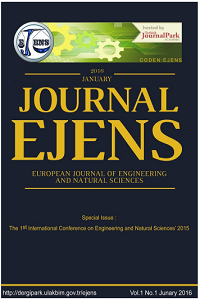A Statistical Model for Predicting Yarn Evenness of Cotton Sirospun Yarns
A Statistical Model for Predicting Yarn Evenness of Cotton Sirospun Yarns
___
- . Rupp, J., 2008, Efficient Yarn Production, September-October, 2008, http://www.textileworld.com, http://www.textileworld.com/Issues/2008/September-October/Features/Efficient_Yarn_Production
- . The Unevenness Limit, www.rieter.com, http://www.rieter.com/cz/rikipedia/articles/technology-ofshort-staple-spinning/reducing-the-unevenness-of-yarn-mass/unevenness-of-yarn-mass/the-unevenness-limit/ (Date Accessed: April 2015)
- . El Mogahzy Y., Broughton R. M., Lynch W. K.; Statistical Approach for Determining the Technological Value of Cotton Using HVI Fiber Properties, Textile Res. J. Vol. 60 (1990) pp. 495-500.
- . Majumdar P. K., Majumdar A.; Predicting the Breaking Elongation of Ring Spun Cotton Yarns Using Mathematical, Statistical, and Artificial Neural Network Models, Textile Res. J., Vol. 74 (2004) pp. 652-655.
- . Frydrych I. and MatusakM., 2002, Predicting the Nep Number in Cotton Yarn Determining the Critical Nep Size, Textile Research Journal, 72: 917-923.
- . Majumdar A., Majumdar P. K. and Sarkar B., 2005, Application of linear regression, artificial neural network and neuro-fuzzy algorithms to predict the breaking elongation of rotor-spun yarns, Indian Journal of Fibre&Texile Research, 30: 19-25.
- . Üreyen M.E. and Kadoğlu H, "Interactions Between AFIS Fibre Properties and Ring Cotton Yarn Properties", Tekstil ve Konfeksiyon, 18 (1), p.8-14., 2008.
- . Hunter L., 2004, Predicting cotton yarn properties from fibre properties in practice, 27th International Cotton Conference, Bremen, Germany, 62-70.
- . Ethridge M. D., Zhu R.; Prediction of Rotor Spun Cotton Yarn Quality: A Comparison of Neural Network and Regression Algori¬thms, Proceedings of the Beltwide Cotton Conference Vol. 2, 1996, pp.1314-1317.
- . Bedez Ute T., Research On Spinning of Short Staple Fibres by Sirospun System, Ege University Graduate School of Natural and Applied Sciences, Master of Science Thesis, 2007.
- . Bedez Üte T., Kadoğlu H., 2014, Regressional estimation of Cotton Sirospun Yarn Properties From Fibre propertiers, AUTEX Research Journal, Vol. 14, No:3, September 2014, p.161-167.
- . Bedez Ute T., Kadoglu H., 2012, "Regressional Estimation of Yarn Hairiness of Cotton Sirospun Yarns From Afis Fiber Properties",6th International Textile, Clothing & Design Conference - Magic World of Textiles, October 07-10, Dubrovnik, Croatia.
- . Bedez Ute T., Kadoglu H., 2012," The Prediction of Yarn Strength of Cotton Sirospun Yarns From AFIS Fiber Properties By Using Linear Regression Analysis", The Inter-Regional Research Network On Cotton For The Mediterranean& Middle East Regions, November 05-07, Antalya.
- . Characteristics of the Raw Material, www.rieter.com, http://www.rieter.com/tr/rikipedia/articles/technology-ofshort-staple-spinning/raw-material-as-a-factor-influencing-spinning/characteristics-of-the-raw-material/, (Date Accessed: April 2015)
- . Uster AFIS Pro Brochures, www.uster.com, Uster Technlogies, http://www.uster.com/en/ instruments/fiber-testing/uster-afis-pro/(Date Accessed: 27 Temmuz 2012)
- . Frydrych I. and Matusiak M., 2002, “Trends of AFIS Application in Research and Industry”, FIBRES & TEXTILES in Eastern Europe, July/September,: 35-39.
- . Ureyen M.E. & Kadoğlu H, 2006, Regressional Estimation of Ring Cotton Yarn Properties from HVI Fiber Properties, Textile Research Journal, Vol 76, 2006, p360.
- Başlangıç: 2015
- Yayıncı: CNR Çevre
A Statistical Model for Predicting Yarn Evenness of Cotton Sirospun Yarns
Tuba BEDEZ ÜTE, Hüseyin KADOĞLU
Selim DOGAN, Havva ATES, Ali BERKTAY
ANALYSIS OF LAMINATED COMPOSITE PLATES USING ELEMENT-FREE GALERKIN METHOD
Ömer Yavuz BOZKURT, Özkan ÖZBEK
Identification of Waste Sources in Ready-Mixed Concrete Plants
Aynur KAZAZ, Serdar ULUBEYLİ, Bayram ER, Ahmet ARSLAN, Murat ATICI
Application of Digital Image Correlation in Uniaxial Tensile Test
Murat AYDIN, Xin WU, Kerim ÇETİNKAYA, İbrahim KADI, Mustafa YAŞAR
The Effects of Irrigation with Treated Wastewater on Crops and Human Populations – A Review
